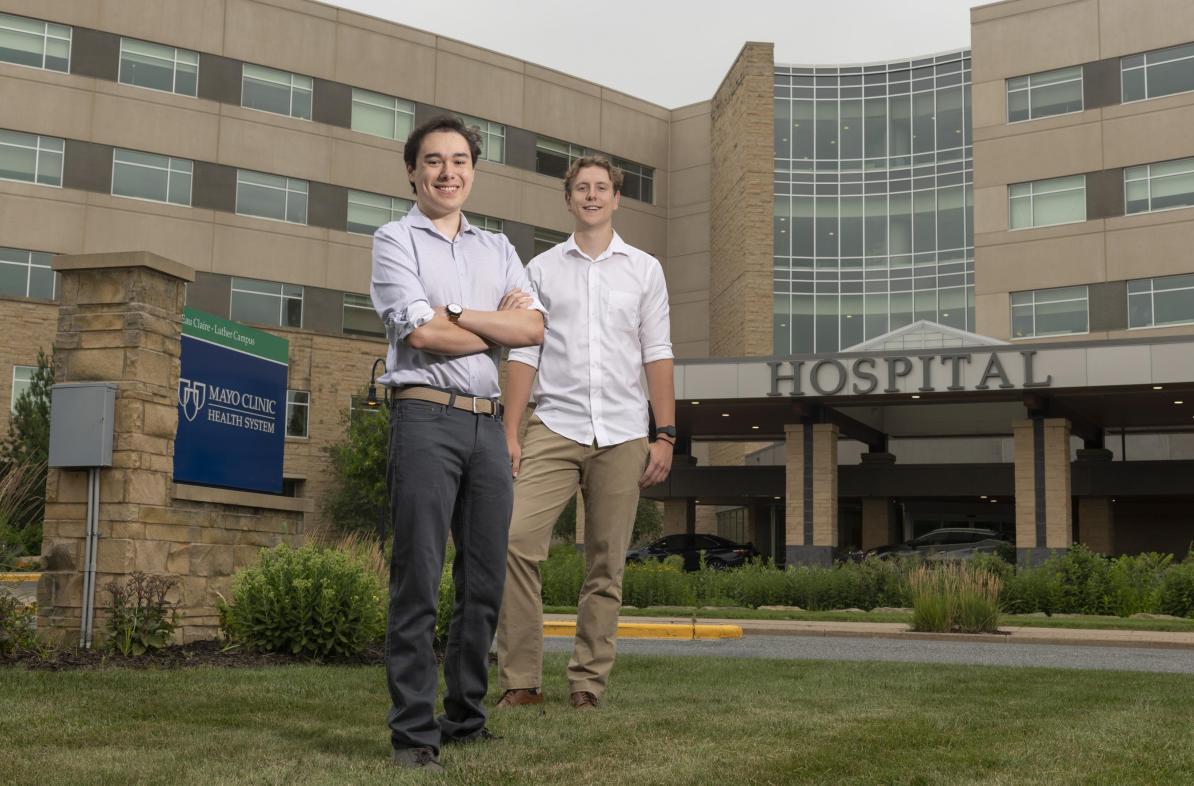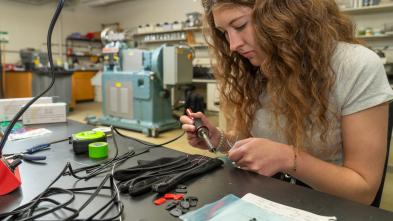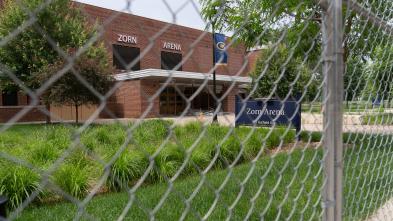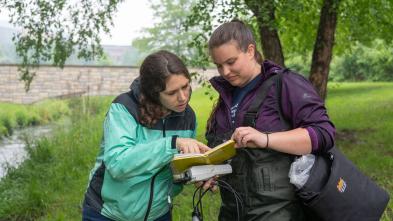
Summer research in Mayo Clinic program shape Blugolds' future career plans
When Sebastian Torres and Nathan Hau came to the University of Wisconsin-Eau Claire both knew they would find plenty of outside-the-classroom opportunities to help prepare them for their future careers in the research and/or health care fields.
Still, neither dreamed they would be part of a physician-led summer research project that would take them into Mayo Clinic Health System operating rooms. Even more surreal is knowing their work — done as undergraduate students — may help shape hospital protocols in ways that will reduce medical costs.
“I was expecting that I would be doing lab work, and I know I would have been content with that experience,” Torres, a junior from Eau Claire, says of the research he expected to do as a Blugold. “When they told us that we would be in the OR during surgeries, my jaw dropped to the floor. I did not see that coming.”
Hau, also a junior from Eau Claire, says he, too, was stunned by the scope and nature of the research.
“Never in a million years did I think that I’d be in a situation where I was in an operating room as an undergraduate student,” says Hau, who plans to attend dental or medical school after earning his degree in biochemistry/microbiology. “Since COVID, I’ve been struggling to find doctors who I could shadow at different health care organizations. So, to go from struggling to do that to observing surgeries in an operating room is incredible.”
Mayo Clinic Undergraduate Research Employment Program
Hau and Torres are part of the Mayo Clinic Undergraduate Research Employment Program, a summer program that pairs physicians with high-achieving undergraduate student researchers.
UREP, which for years was offered at Mayo Clinic in Rochester, Minnesota, was available for the first time in Eau Claire in 2019. While UREP was paused in 2020 because of COVID-19, this summer five Blugolds, including Hau and Torres, are again part of the program in Eau Claire.
“When I learned about this program, I was immediately interested,” Hau says. “It seemed like a great thing for me to do for so many reasons. It will give me experience with research and it will give me connections within Mayo Clinic. It’s just a great all-around opportunity.”
The Blugolds are working on two summer research projects at Mayo Clinic Health System: a quality improvement project led by Dr. Jason Beckermann, a physician in general surgery, and a literature review led Dr. Brandon Hidaka, a physician in family medicine.
The physicians welcome the opportunity to work with ambitious students who have an interest in biomedical research and/or a career in health care.
“Working with students is exciting as their enthusiasm motivates me to make time for projects that otherwise get put on the back burner due to patient care responsibilities,” Beckermann says. “Students also are way more tech savvy than I am, so working with them exposes me to new apps and computer technology I would not be exposed to without this program.
“Collaboration between UWEC and Mayo is beneficial to medical providers, students and most importantly, translates into better care for patients in our community.”
Hidaka also sees great value in collaborating with the university, describing UREP as a “win-win-win.”
“The students have access to a funded experience in health research that will better position them for their future endeavors,” Hidaka says. “The Mayo staff receive much-needed assistance from top-notch students. Together, we are able to advance science that will eventually lead to better health outcomes.”
While students work closely with the physicians, they also interact with people who work in positions throughout the medical center, says Dr. Julie Anderson, director of UW-Eau Claire’s Health Careers Center. Those interactions help students see the breadth of careers within health care, build professional connections and get a sense of what it is like to work in a medical setting, she says.
This year, more than 50 students applied for UREP in Eau Claire. Of the seven students selected, five are Blugolds. In addition to Hau and Torres, UW-Eau Claire UREP students are Christine Le, a biochemistry/molecular biology major from Richfield; Samuel Petit, a neuroscience major from Eau Claire; and Emily Vanderpas, a biochemistry/molecular biology major from Appleton.
“They are all outstanding students with very promising futures in medicine,” Anderson says. “I have heard positive feedback from many Mayo Clinic Health System staff about how rewarding it is to work with UWEC students who are very eager to learn and contribute.”
Seeing the “inner workings” of clinical care, while also contributing to research that will help to improve care and make a positive impact on patient outcomes, helps students gain confidence that they are choosing a career path that is a good fit for them, Anderson says.
That’s true for Torres, who will do research in the coming semesters with UW-Eau Claire faculty but was eager to also have experiences away from campus.
“I knew this program would be a good way to add to my research experiences, but I also looked at it because it was medically oriented,” says Torres, a biology/microbiology major and Spanish minor who is pursuing a certificate in information systems. “It’s a good opportunity to see if health care is a field I might want to pursue. These summer projects definitely have me thinking about it more seriously.”
Reducing waste, saving money
For their project with Beckermann, Hau and Torres are documenting the efficiencies and cost savings that come from standardizing the instrument trays used during some common surgeries.
Previous research has shown that typically less than 50% of instruments opened for a surgery are actually utilized, Beckermann says.
“We have worked with the surgical teams to consolidate instrument trays for several operations,” Beckermann says. “Nathan and Sebastian are collecting data on how much time is saved in the operating room and in central processing using the new instrument trays. Our objective is to demonstrate how this can decrease the cost of medical care.”
Hau and Torres are notified whenever certain surgeries are scheduled so they can go to the medical center to evaluate the time required for personnel to prepare the room, count instruments and clean up instrument tables. They also document the time required for processing, sterilization and repackaging of instruments in central processing, where surgical instruments are cleansed and sterilized.
“It’s a huge process and we follow it from the beginning to the end,” says Hau, noting that it includes spending time in the operating room and in central processing. “From the start to the end, it can take four to eight hours to turn an instrument tray around.”
“It really opened our eyes to what goes on in surgery but also in central processing,” Torres says. “I had no idea what went on in central processing, but that’s where there will be the most cost efficiencies.”
Eventually, their report will be shared with other surgical teams. By presenting the cost savings, the hope is that other surgical teams will consolidate their instrument trays, which will reduce costs across surgical services.
Beckermann is optimistic that the project will achieve its goals, and that Hau and Torres will take away knowledge and skills that will help them be successful in the future.
“Nathan and Sebastian have been great to work with,” Beckermann says. “They are both hard working, enthusiastic and motivated to expand their knowledge base.”
Review of literature
For their project with Hidaka, Torres and Hau are reviewing all published literature that looks at whether a fever helps adults recover faster from a viral upper respiratory infection, such as COVID-19 or a cold.
“People frequently take fever-blocking medicines like acetaminophen and ibuprofen when they have a cough or sore throat, but we hypothesize that it may prolong their illness because fever is a helpful defense used throughout the animal kingdom,” Hidaka says.
At the start of the summer, the students had more than 8,750 abstracts to consider for the project. Of those, they have identified more than 125 full papers that need to be read and summarized.
“I am incredibly fortunate to involve UWEC undergraduates on this project,” Hidaka says. “Their efforts have exponentially accelerated this project. They are reviewing abstracts and full texts based on specific exclusion criteria to identify all of the relevant studies. For the final set of studies, the undergraduate researchers are reviewing the study quality and extracting the relevant data so we can perform a meta-analysis, which will give us an estimated, across-different-studies effect of how fever blockade influences the resolution of viral upper respiratory infections.”
The project is helping them hone some valuable skills, Torres says, describing it as “great practice for data collection, analysis and extraction.” The ability to review, assess and summarize large amounts of complex literature will be important in graduate or medical school and in their future careers, he says.
When the project is complete, the research team plans to write a paper to submit to medical journals for potential publication. Hau says their literature review also will identify additional questions to be addressed in future projects, which will extend the reach and impact of their project.
“Nathan and Sebastian have been extremely valuable in this research project,” Hidaka says. “They have worked diligently and brought up several important methodologic questions.”
Helping shape their futures
Already, Torres and Hau say, the UREP projects are changing how they are thinking about their futures.
Torres’ plans have long included earning a Ph.D. in microbiology, preparing him for a career in research. Now, he is considering a career path that may take him into health care.
“It’s so cool,” Torres says of being in the operating room. “Walking into that room is adrenaline inducing. It has me thinking about a medical-related field, something I didn’t think I wanted. I’m not so sure any more about what I want to do but I feel like I have even more options now.”
Watching people do their day-to-day work has given him a better understanding of and appreciation for the many different jobs within health care, Torres says.
“We are getting to see what all of these different people do every day and it’s incredible,” Torres says. “By observing a job, I can appreciate it so much more. It’s different than just reading a job description or talking to someone about a job. It definitely has me thinking about things a little differently.”
Observing every step of the surgical process — from setup to cleanup — also has made him aware of jobs he never knew existed, each one important to the success of the surgical team, Torres says.
So far, they’ve observed about a dozen surgeries this summer, and everyone from surgical technicians to surgeons have taken time to explain what is happening at every step, Hau says.
“It’s awe-inspiring to see what happens in the OR,” Hau says. “There is something so delicate going on. To get to see that, it’s been really incredible.”
Hau came to UW-Eau Claire planning to apply to dental or medical school after he graduates. While that’s still his plan, he also now sees even more potential paths he could take within health care.
For the first time, Hau can imagine himself as a surgeon.
“It’s not something I ever thought about,” Hau says. “It’s not something I thought I’d do because it seemed so extreme, something beyond what I could do. But after observing these surgeries and seeing it through their eyes, I’m thinking that I could see myself doing it someday. I can see it as a possibility.”
Thriving as Blugolds
Growing up in Eau Claire, Hau and Torres have long been aware of UW-Eau Claire’s strong science programs and the university’s nationally recognized undergraduate research program.
“I love the small classes and the focus on research,” Hau says of being a Blugold, adding that UW-Eau Claire also gave him a chance to play college basketball.
Torres, whose father, Dr. Eric Torres, was a longtime faculty member, grew up hearing about the university’s strengths, and could see through his father’s work the value of undergraduate research.
While their first two years of college have not gone as planned because of COVID-19, Torres and Hau still are finding plenty of highly engaged faculty and many interesting opportunities on campus.
The UW-Eau Claire and Mayo Clinic Health System research agreement will continue to create many unique opportunities for students to learn about careers in health care, Anderson says.
“The future for students at UWEC who are interested in pursuing careers in biomedical research and/or health care is very bright,” Anderson says. “We look forward to continuing to grow programs like UREP and developing others that help students to develop into future leaders and important contributors to human health and well-being.”
Hau and Torres are eager to make the most of those opportunities.
“The things we’re doing here are priceless,” Hau says. “Especially after COVID, I realized how important it is to find and appreciate every opportunity. These experiences are shaping my future and helping me decide what I want to do with my life. I really appreciate every experience.”
You may also like


